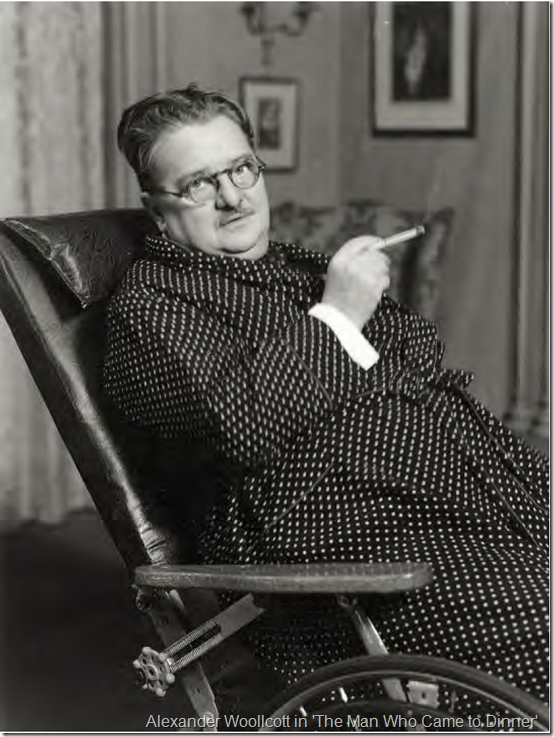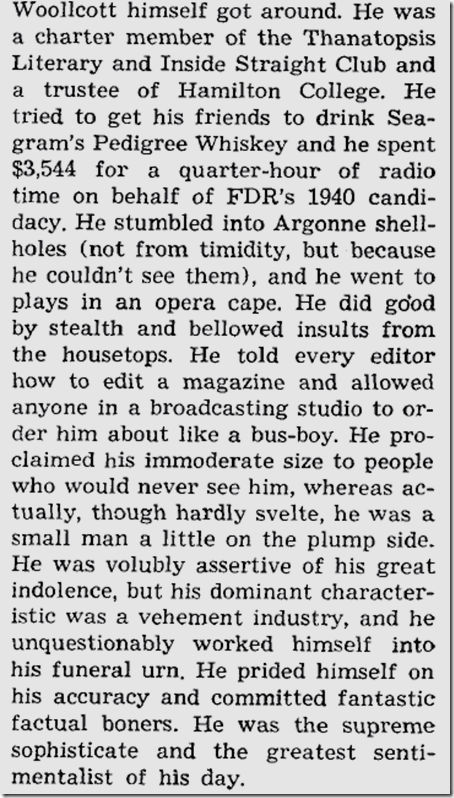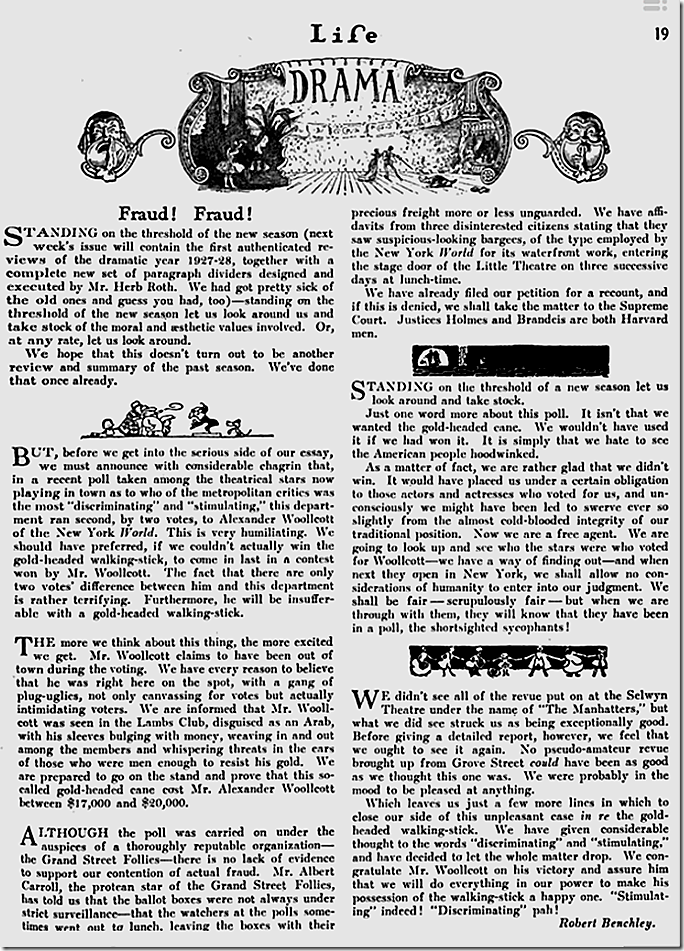
New York critic, columnist and radio pundit Alexander Woollcott makes an endorsement for Pullman in 1940. Courtesy of the Illinois Digital Archives. In Vera Caspary’s novel “Laura,” New York columnist Waldo Lydecker endorses the Byron pen, renamed the “Wallace Flow-Rite pen” for the film.
In case you just tuned in, I’m using Louella Parsons’ May 15, 1944, item on Rouben Mamoulian being replaced as the director of “Laura” to take a meandering look at the making of the film, which was released in Los Angeles in November 1944. Previous posts have examined the writing career of “Laura” novelist Vera Caspary and the state of the detective story in 1941, when she was writing the novel. We also explored some of the locations Caspary used in the book.
At long last, after examining each of the characters in the novel, we’re going to look at Caspary’s portrayal of Waldo Lydecker (played by Clifton Webb in the film), the most important person in the novel and in the film, even though both are titled “Laura.”
The Making of “Laura” Part 1 | Part 2 | Part 3 | Part 4 | Part 5 | Part 6 | Part 7 | Part 8 | Part 9 | Part 10 | Part 11 | | Part 12 | Part 13 | Part 14 | Part 15 | Part 16 | Part 17 | Part 18 | Part 19 | Part 20 | Part 21 | Part 22 | Part 23 | Part 24 | Part 25 | Part 26 | Part 27 | Part 28 | Part 29
James Ellroy to script remake of ‘Laura’
Spoilers ahead
Caspary says in her autobiography, “The Secrets of Grown-Ups”:
“Night after night, Ellis [St. Joseph] and I sat up, talking about Waldo Lydecker, the impotent man who tries to destroy the woman he can never possess. We developed his background, imagined his youth, analyzed the causes of his frustrate masculinity, considered his taste, his talent, his idiosyncrasies.”

Alexander Woollcott as Sheridan Whiteside — a character modeled at least in part on Woollcott — in the George S. Kaufman and Moss Hart play “The Man Who Came to Dinner,” from the New York Public Library, via an essay by Mary Jo Binker.
Few people believed Caspary when she insisted that she did not base the character of Waldo Lydecker on the irascible and yet sentimental and beloved newspaper columnist and radio pundit Alexander Woollcott. As Walter Winchell said in his July 31, 1944, column: “The author always denied that the crime-writer-columnist-radiorator villain was [Alexander] Woollcott but sophisticated New Yorkers will immediately think it is. Even though he is called Waldo.”
Woollcott died in 1943, before the release of the movie version of “Laura,” but he was still alive, though in declining health, when the novel was published. Curiously, he apparently never commented on parallels between him and Waldo. One can only speculate on whether he would have been pleased or outraged or both. (Although the prevailing wisdom is that the character of Sheridan Whiteside in the Kaufman-Hart play “The Man Who Came to Dinner” was based on Woollcott, an assumption bolstered by Woollcott’s appearance as Whiteside in touring productions, there is a small, contrarian thread that Whiteside was inspired at least in part by an incident in the life of George Bernard Shaw. Consider this account of Shaw in a 1931 Shouts and Murmurs column … by Woollcott.)
Here is Woollcott in a 1933 episode of “The Town Crier” and in a 1941 radio show, “Speaking of Liberty,” hosted by Rex Stout. Courtesy of Archive.org.
It’s beyond the scope, even of this meandering analysis, to undertake a biography of a sprawling personality such as the Algonquin Round Table’s Woollcott. Instead, here’s an informative episode from the NBC radio series “Biography in Sound” that quotes a number of notables (including screenwriters Charles Brackett and Ben Hecht, Orson Welles and many others) in recounting Woollcott’s life.
Woollcott’s radio biography begins with quotes from several friends: “The rudest and the kindest man I ever knew… If he was a snob, he was an amiable and genial snob… He could be difficult, rude and unpleasant when something displeased him…. He could also be absolutely enchanting…. one of the kindest men in the world…. He was not handsome. He was ugly….” Others say: “He looked like a very heavy owl…” “He weighed 230 pounds and was not very tall.”
John T. Winterich describes Woollcott this way in the June 2, 1945, Saturday Review in critiquing the biography “A. Woollcott: His Life and World” by Samuel Hopkins Adams, (via Unz.org):

In other words, a fairly accurate description of Waldo Lydecker — with one of the few distinctions being Waldo’s height and “graying Van Dyke” (Page 16). As portrayed by Caspary, Waldo is 52 (Woollcott would have been 54 in 1941). Waldo is 6-feet-3 but overweight, despite attempts to diet. “My skeleton is hidden by the weight of my flesh,” he says (Page 19). Since childhood, he has had poor eyesight that prevented him taking part in athletics, just like Woollcott. Waldo describes himself as “a fat, fussy, useless male of middle age and doubtful charm” (Page 21).
Caspary apparently had great fun writing in Waldo’s voice in an imitation of Woollcott. In her novel, Waldo is rude in a charming way; he’s snide and sarcastic, superior and condescending and yet amusing; his friendship is conditional. He’s an eccentric collector of antiques and old bric-a-brac who cultivates the persona of an extravagant bon vivant. Most important, Waldo knows that his life is an act and that much of the time he’s putting on a show. Despite all the vitriol he spews at others, Waldo saves his most critical venom for himself — and in this he is much like Woollcott, according to his friends.
And in one final curious note, while delving through old copies of Life (the 1920s humor magazine, not the more familiar Luce publication), we found this mention of Woollcott in an Aug. 25, 1927, column by fellow Algonquin Round Table member Robert Benchley whimsically referring to a gold-headed walking stick. Might this have inspired Caspary’s more lethal version, which Waldo uses as a murder weapon in “Laura?”

To be continued.


Mr. Harnisch, if you are at all interested in further information about Alexander Woollcott, I can recommend Smart Aleck by Howard Teichmann. (I’m sure you have a pile of books already that you don’t have time to read, so I hope you’ll ignore this suggestion if one more book will topple the pile.)
LikeLike
Thanks! I had fun researching this post. He was a character and a half.The biography in sound was interesting, just to see how radio biographies were done at the time.
LikeLike
Woollcott invited Harpo Marx into the Algonquin Round Table, where he fit in famously. Marx tells all sorts of anecdotes about Woollcott in his autobiography.
LikeLike